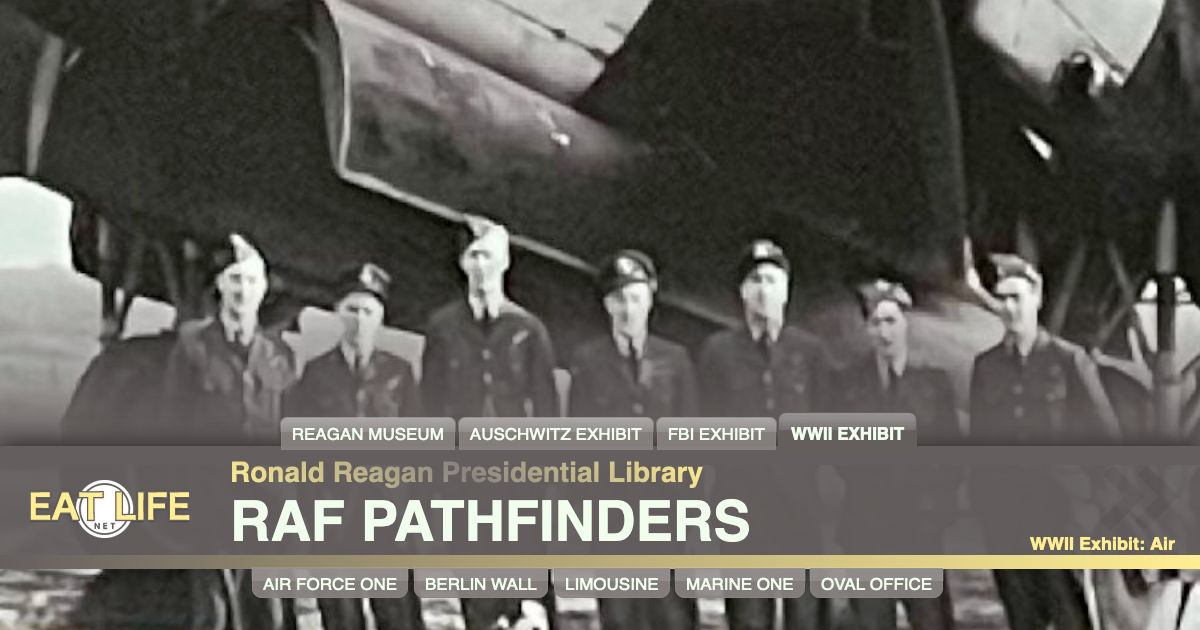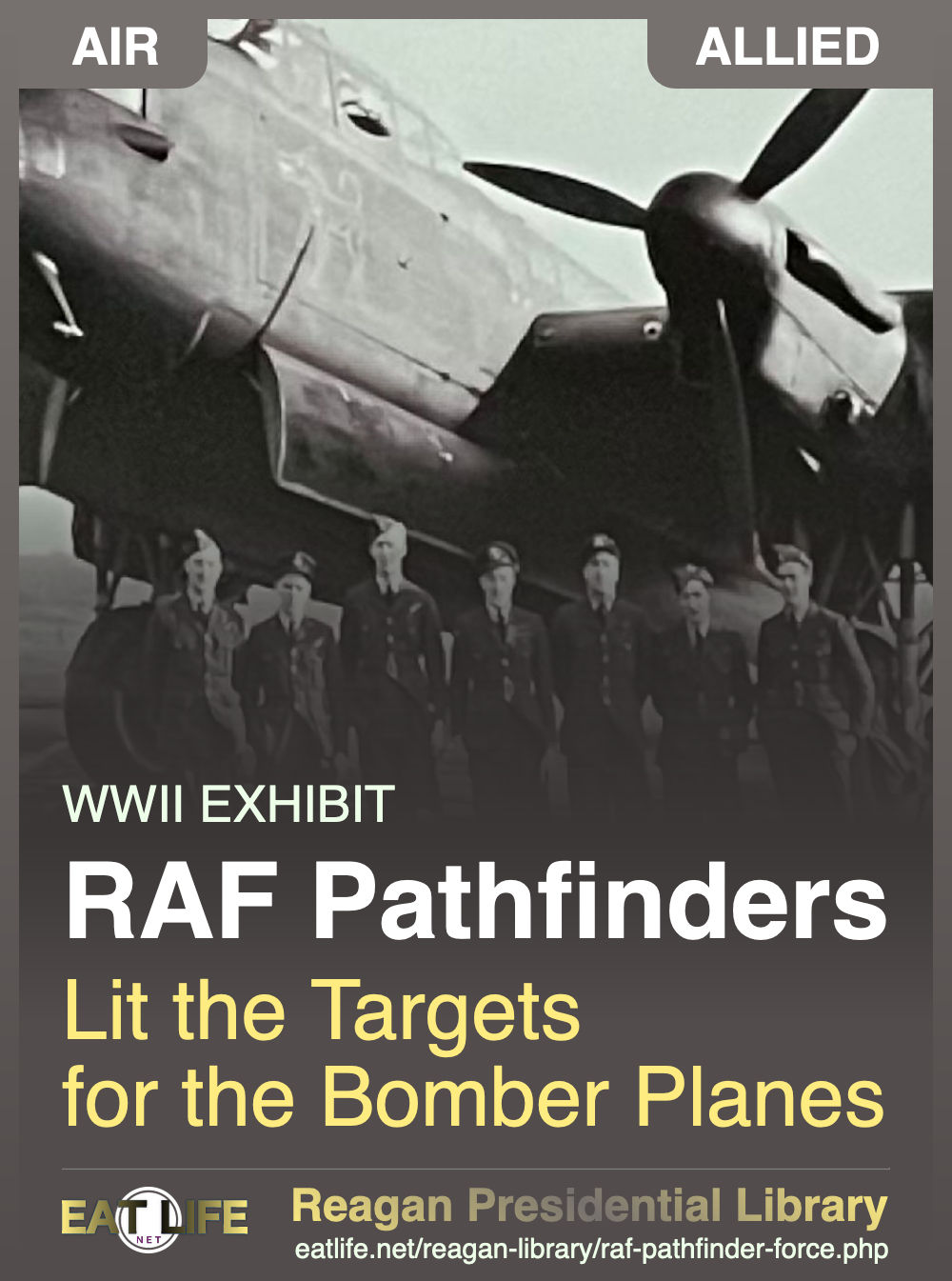The Royal Air Force Bomber planes kept getting shot down so they decided to start doing bombing raids at night. But it was very difficult to hone in on the target at night unless it was in a city. They started using Pathfinders
- The first pathfinder planes dropped white light along the attack route
- The second group would drop colored flares on the target
- The third group dropped incendiary bombs on the colored flares
- Heavy bombers drop bombs on the flames
They got very sophisticated marking targets by radio and dropping different color lights for bombers to attack in order by color.

Light up the Night
Royal Air Force Pathfinders were target marking squadrons, part of the Bomber Command. In January 1943, the squadrons became the No. 8 (Pathfinder Force) Group, ultimately growing to nineteen squadrons. Their planes would locate the targets and light them up with flares so the rest of the bombers could fire with greater accuracy. The Pathfinders had the latest equipment, such as the GEE radio navigation system, H25 radar, the Oboe guidance system, and the newest planes.
When ten of twenty two RAF bombers were shot down German fighters on a raid December 18, 1939, Bomber Command knew they needed to change tactics. Bombers either needed fighter escorts during daylight flights, or the missions needed to happen at night.
While enemy forces were not likely to spot them in the dark, it made homing in on the target more difficult. Initially, night bombing runs were limited to cities. The RAF did not have sophisticated navigation systems at the time, and relied on visual sighting of the targets. The RAF began a night bombing campaign in 1940, but quickly received reports that the bombs were not dropped on their targets, indeed sometimes not in the area. Many fell in open countryside, and it was estimated that only 1% of the bombs even landed near their target. Some wanted to end night runs altogether. The UK began developing navigation aids that would assist night missions, but they were slow to produce. The RAF thought about copying the Luftwaffe strategy of giving the equipment to the lead force, but realized it would lead to rivalry and jealousy among the pilots.
 In August 1942, a specialized group known as the Pathfinder Force (PFF) was created with five squadrons transferred from the Bomber Command Groups.
The first PFF missions were not successful, and their techniques were changed.
In August 1942, a specialized group known as the Pathfinder Force (PFF) was created with five squadrons transferred from the Bomber Command Groups.
The first PFF missions were not successful, and their techniques were changed.
PFFs would be split into three groups on each raid.
- The first group dropped white light along the attack route, allowing the other planes to follow the flight path.
- The second group would drop colored lights on the target once it had been verified. Using colored flames meant the Germans couldn't light decoy fires.
- The third groups used the colored flares as targets for dropping their incendiary bombs, whose flames would then mark the target for the heavy bombers.
Their abilities grew more sophisticated. On a raid on June 20-21, 1943, PFFs marked their targets based on radio instructions from a Master Bomber, and experience Pathfinder who cirded the target and directing the aircraft around him. During attack on August 17-18 1943, PFFs dropped different color lights and called for bombers to attack in order by color. The Light Night Striking Force (LNSF) used the Mosquito bomber, which was fast but still able to carry large loads for long distances.
The most skilled pilots were recruited as Pathfinders. The PFFs flew over 50,000 missions over almost 3500 targets, and over 3700 were killed in action.
Tactics
The proportion of Pathfinder aircraft to Main Force bombers could vary according to the difficulty and location of the target; 1 to 15 was common, though it could be as low as 1 to 3. By the start of 1944, the bulk of Bomber Command was bombing within 3 miles of the PFF indicators, an appreciable improvement in accuracy since 1942. The success or failure of a raid now largely depended on the Pathfinders' marker placement and the success of further correction marking.PFF crews found themselves given ever increasingly sophisticated and complex jobs that were constantly modified and developed tactically during the bombing campaign from 1943 until the end of the war. Some of the more usual tasks were as
- Finders these were 8 Group aircraft tasked with dropping sticks of illuminating flares, firstly at critical points along the bombing route to aid navigation and keep the bomber stream compact and then across the approximate target area. If conditions were cloudy then these were dropped "blind" using H2S navigational radar.
- Illuminators were PFF aircraft flying in front of the main force who would drop markers or target indicators (TIs) onto the designated 'aiming point' already illuminated by the "Finders". Again, if conditions were cloudy H2S navigational radar was used. These TIs were designed to burn with various and varying colors to prevent the German defenses lighting decoy fires. Various TI's were dubbed "Pink Pansies", "Red Spots", and "Smoke Puffs". "Illuminators" could include Mosquitoes equipped with "Oboe" if the target was within the range of this bombing aid.
- Markers would then drop incendiaries onto the TIs just prior to the Main Force arrival. Further "Markers" called "Backers-Up" or "Supporters" would be distributed at points within the main bomber stream to remark or reinforce the original TIs as required.
As the war wore on, the role of "Master Bomber" was introduced. This was an idea that had been used by Guy Gibson in the Dam Busters raid. Bennett wanted to lead raids but was denied operational flying as Harris was not prepared to risk losing him. The appointed Pathfinder (usually an experienced senior officer) circled the target, broadcasting radio instructions to both Pathfinders and Main Force aircraft, correcting aiming points and generally coordinating the attack. In September 1944, Gibson himself died in a Mosquito after performing as "master bomber" for a raid on Germany.
Marking
Three types of target marking were developed by the Pathfinders. These were known by the codenames Parramatta, Wanganui and Newhaven – the names coming from locations in Australia, New Zealand and the UK which had links with Pathfinder staff. If the Oboe system was used to determine the release point then the word "Musical" was used as a prefix, e.g. "Musical Parramatta".
- Parramatta used navigation aids such as H2S radar or Oboe radio signals to drop the markers.
- Newhaven used illumination flares dropped above the target area to light it up sufficiently for a visual marking by the Pathfinder aircraft.
- Wanganui was used when the target was obscured by cloud, industrial haze, or a smoke screen. Oboe or H2S was used to release the markers over the unseen target. The target indicators used were on parachutes to give an aiming point that could be seen by the main force. This was also known as "sky marking".
In all cases, further target Indicators would be dropped in the course of the raid to reinforce the marking and to compensate for earlier TIs either burning out or being extinguished by the bombing.








